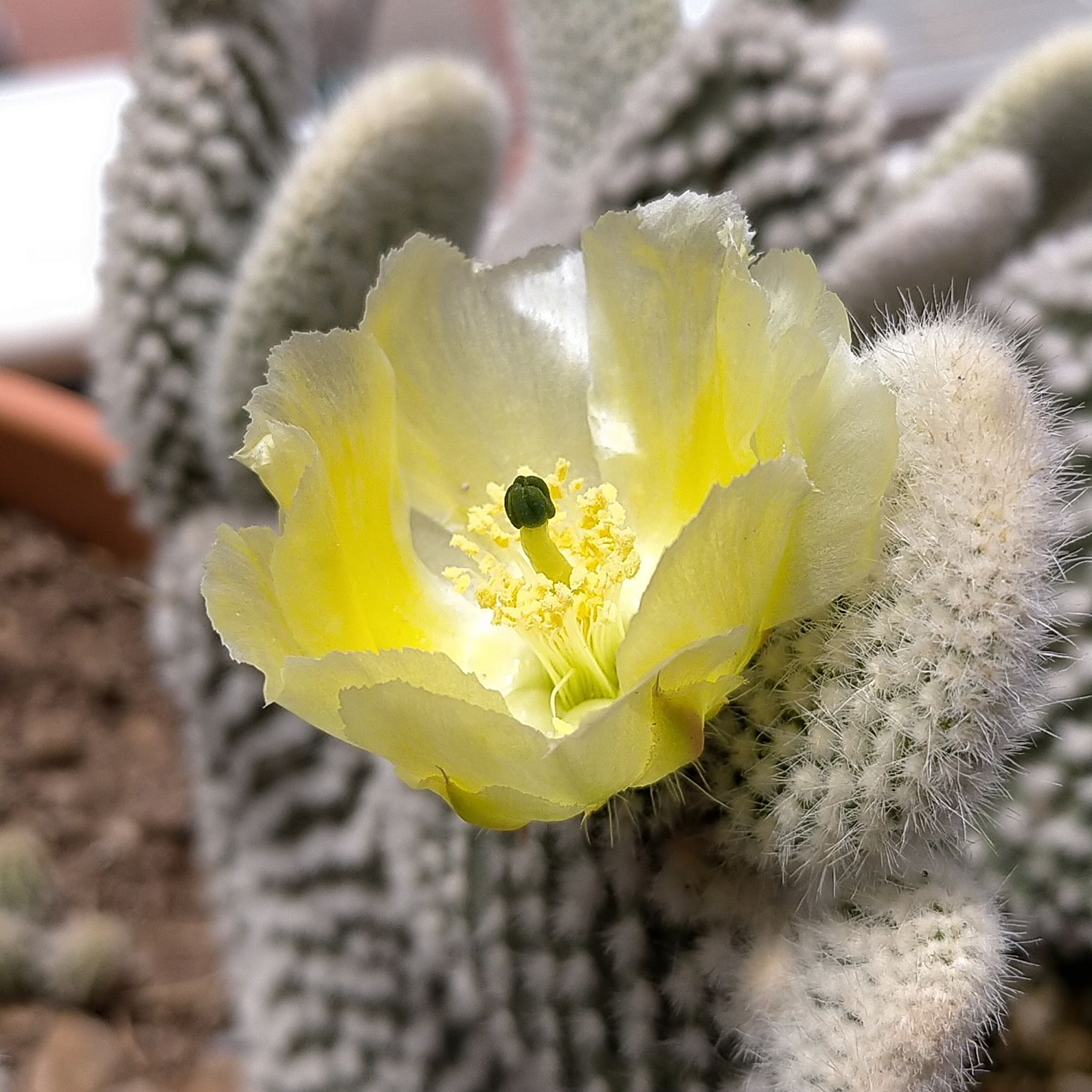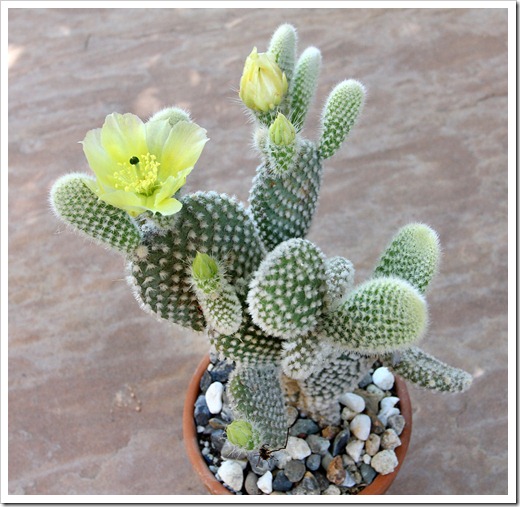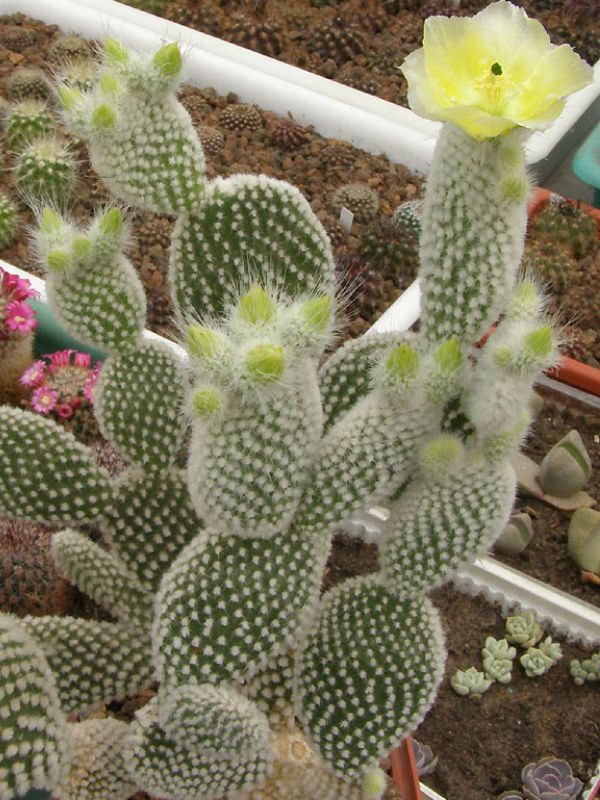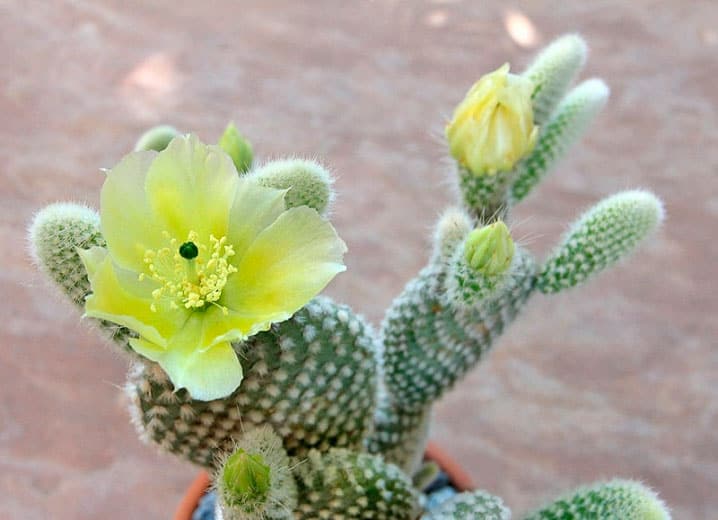
Primera flor de nopalillo (Opuntia microdasys), de 2021
Description: Shrub to 1 m high; joints flattened, orbicular to oblong, velvety-pubescent, yellowish-green, 7-15 cm long; areoles close-set, with many yellow glochids arranged in conspicuous tufts, occasionally with a short yellow spine; leaves deciduous. Flowers yellow or tinged red, 4-5 cm across. Fruits subglobose, red. Opuntia microdasys

Plant World Opuntia microdasys
The Opuntia microdasys is a cactus that has its origins in Mexico. This cactus is commonly referred to as the bunny cactus or polka-dot cactus. It grows in the form of a shrub and bears multiple pads that emerge from a central stem, often resembling a bunny. The pads and stems also have white prickles or spots bearing white hair without any spines.

Opuntia microdasys var. albispina World of Succulents
Publication: CABI Compendium https://doi.org/10.1079/cabicompendium.37720 Datasheet Types: Host plant, Crop, Invasive species Abstract This datasheet on Opuntia microdasys covers Identity, Overview, Distribution, Uses, Further Information. Identity Preferred Scientific Name Opuntia microdasys (Lehm.) Pfeiff. Preferred Common Name angel's wings

Opuntia microdasys (Angel'sWings, Bunny Ears, Polka Dot Cactus) North Carolina Extension
Opuntia microdasys is a popular cactus that forms a dense shrub with green pad-like stems with no spines but numerous yellow glochids at each areole. It grows up to 3 feet (90 cm) tall and up to 6 feet (1.8 m) wide. Stems are oval to round, up to 6 inches (15 cm) long, and up to 5 inches (12.5 cm) wide. Flowers are pure yellow or tinged with.

Opuntia microdasys subsp. rufida is an upright and spreading, much branched cactus... opuntia
Opuntia microdasys Common Name (s): Angel's-Wings Bunny Ears Polka Dot Cactus Phonetic Spelling op-UN-shee-a my-kro-DAS-is Description Bunny Ears Cactus is native to northern Mexico and desert regions stretching into Arizona. This plant will grow 2-3 feet tall and spread 4-6 feet as a mature plant.

Opuntia microdasys Le Cactus Fleuri
The Opuntia Microdasys 'Bunny Ears' is a cactus that is native and endemic to central and northern Mexico. Other common names include 'Angel's Wings', 'Bunny Cactus' and 'Polka-Dot Cactus'. These cacti grow thick, segmented, succulent pads that are covered with glochids or short, bristly hairs. These glochids come off easily.

🌵 Opuntia Microdasys Th Cactus
Opuntia microdasys var. microdasys (Lehmann): The father of all bunny ears.This cactus holds on to its true leaves for much longer than its descendants. It's tan areoles are also much smaller than the other bunny ear's especially on immature cladodes.. CAUTION: Opuntia species have fine, barbed bristles called glochids. Glochids easily detach and can become loose in the box during shipping.

a flor do Opuntia microdasys Pesquisa Google Kaktüs
Cact. 154 1837 Family: CACTACEAE Opuntia microdasys Photo by: Diego Armentano Origin and Habitat: Mexico (Coahuila, Hidalgo, Jalisco, Nuevo León, Querétaro, San Luis Potosí, Tamaulipas, Zacatecas). This species is widespread and common. Habitat and ecology. They are usually found in desert hills and uplands at 1700-2100 metres above sea level.

Opuntia_microdasys Giromagi Cactus and Succulents
Kingdom: Plantae: Plants, but not fungi, lichens, or algae: Subkingdom: Tracheobionta: Vascular plants—plants with a "circulatory system" for delivering water and nutrients

Opuntia microdasys (Cactaceae) Opuntia microdasys, Cactus, Bunny ear cactus
A collection of opuntia microdasys cactii. They usually require only occasional watering. Many growers prefer to use a tray under their pot to allow the soil to drain out properly and throw away any excess water. During the autumn and winter, you should water your Bunny Ears cactus only once every three to four weeks.

Opuntia microdasys albispina Helmut Matk Kakteenkulturen
7 likes, 0 comments - my._.paradise0 on September 8, 2023: " Opuntia microdasys (angel's-wings, bunny ears cactus, bunny cactus or polka-dot cac." My Paradise on Instagram: "🌵Opuntia microdasys 😍 (angel's-wings, bunny ears cactus, bunny cactus or polka-dot cactus) is a species of flowering plant in the cactus family Cactaceae, native.

Opuntia microdasys subs. rufida minima Cactus plants, Cacti and succulents, Opuntia microdasys
The flowering of Opuntia microdasys bunny ears is uncommon as potted plants. However, the opuntia blooms abundantly when plants are in the ground. The bloom time is in early spring. with the flowers sitting on the outer edges of the pad-like stems. Opuntia microdasys blooms are bowl-shaped, red-tinged or with pure yellow flowers.

Pin em suculentas cactos e outras
A Opuntia microdasys var. pallida é uma espécie de aparência muito semelhante à da Opuntia microdasys comum, pois ela também possui a característica de orelhas de coelhinho, mas seus glochídeos são da cor amarelo vivo. Suas flores também são bem parecidas com as da sua espécie, com pétalas leves, quase transparentes, da cor verde.

Opuntia microdasys ‘Alba’ (White polka dot cactus)
Opuntia microdasys is a shrub (stem succulent) that is not native to California. D J J J A S O N A F M M Bloom Period Photos on Calflora

Opuntia Microdasys Opuntia microdasys Buijsman Thermagreast
Description. Opuntia microdasys forms a dense shrub 40-60 cm tall, occasionally more, composed of pad-like stems 6-15 cm long and 4-12 cm broad.. Instead of spines it has numerous white or yellow glochids 2-3 mm long in dense clusters. They are barbed and thinner than the finest human hairs, detaching in large numbers upon the slightest touch.

Opuntia microdasys "albata" (= albispina)
Opuntia microdasys: An evergreen cactus / succulent with green foliage and yellow flowers in spring and summer followed by red and purple fruit. Attractive to bees and hummingbirds. To grow well, it prefers sun - bright shade and occasional - low water. Drought tolerant once established. Prefers to be dry in winter. Grows best in well-drained, lean, gritty and rocky soil.